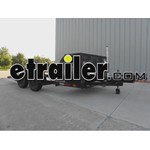
Passenger Side Free Backing Brake Heating Up and Braking Problems on Trailer
Question:
Replaced all at same time. Master cylinder,drums, bearings, loaded backing plates and tires. Each trip, passenger side is at least twice as hot as other side. Enough heat to noticably heat up the fender after it sits. 3 trips so far probably 100 miles total. After braking I can feel resistance to roll freely forward like brake hanging up after its applied. If allowed to roll backwards it doesnt resist movement. After rolling backwards it will roll forward without resistance. Ive pulled both drums both sides look the same, no heat discoloration, bearings and races look fine. Just a little more brake dust on the passenger side which I would expect.
asked by: Gary
Expert Reply:
There could be a couple of things going on here but you have done well to take a look at all the parts to make sure they are in good working order. First, it is important to note that even free backing brakes require initial adjustment. TITAN Surg-O-Matic trailer brakes incorporate a back up feature that makes it necessary to rotate the wheels in the direction of forward rotation only when making adjustments.
The brake adjustment nut is located behind a slot at the bottom of the backing plate. Tighten until you cannot rotate wheel by hand, then back off the adjustment 1 a to 12 notches. ALWAYS ROTATE DRUM IN DIRECTION OF FORWARD ROTATION ONLY.
Another problem could be air in the lines which can result from a problem with bleeding the brakes prior to use. The brake instructions, which I have linked for you, provide good instructions on bleeding the brakes:
Fill master cylinder with fluid. Install bleeder hose on first wheel cylinder to be bled, (if tandem axle trailer, bleed rear axle first). Have loose end of hose submerged in brake fluid in glass container toobserve bubbling.
By loosening the bleeder screw located in the wheel cylinder one turn, the system is open to the atmosphere through the passage drilled in the screw.
Pump actuator with long steady strokes. The bleeding operation is completed when bubbles no longer rise to the surface of the fluid. Be sure to close bleeder screw securely. Repeat bleeding operation at each wheel cylinder.
During the bleeding process, replenish the brake fluid, so the level does not fall below the 1/2 full level in the master cylinder reservoir. After bleeding is completed, make sure master cylinder is filled to 3/8 inch below the top of the reservoir, and filler cap securely in place. I have included a link to a video showing the procedure.
Also, make sure that the master cylinder you have is for drum brakes and not disc brakes. Drum brakes require less pressure than disc brakes. Too much pressure in the system can damage the wheel cylinders.

Product Page this Question was Asked From
Dexter Galphorite Free-Backing Hydraulic Trailer Brake Assembly - 10" - Right Hand - 3,750 lbs
- Accessories and Parts
- Trailer Brakes
- Hydraulic Drum Brakes
- RH
- 3500 lbs
- Brake Assembly
- Free Backing
- 10 x 2-1/4 Inch Drum
- Dexter
more information >
Featured Help Information
Miscellaneous Media

Continue Researching
- Q&A: Bearing Kit for 3,500 lb Trailer Hub
- Q&A: Free Backing Hydraulic Trailer Brakes Not Allow Trailer To Back Up
- Q&A: Replacement Hub & Drum For UFP HD-1377-10 & Hydraulic Brakes For Boat Trailer
- Q&A: Trailer Hub/Drum to Replace Damaged UFP HD-1377-10
- Q&A: Picking Out Replacement Actuator Shock for Gabriel MPD 85746
- Q&A: Greasing EZ Lube Spindles When Grease Comes Out Cotter Pin Hole
- Q&A: How to Measure to Determine the Size Trailer Brakes Needed For Hydraulic Drum Replacement
- Article: Parts Needed to Add Electric Drum Brakes to a Trailer
- Article: How to Bleed Your Trailer Surge Brakes
- Article: 5 Tell-Tale Signs It’s Time to Replace Your Trailer’s Leaf Springs
- Article: How to Tell the Weight Rating of a Trailer Axle
- Article: Trailer Jacks
- Article: Most Popular Wheel Bearings
- Article: How to Measure a Trailer Axle





